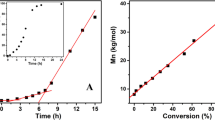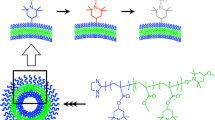Abstract
This paper describes that synthetic polymer vesicles undergo a human erythrocyte-like morphology transformation in response to temperature changes. The normally biconcave discoid erythrocytes, i.e., the discocytes, are transformed into various shapes by their environmental stresses. Poly(methacrylic acid)-block-poly(n-butyl methacrylate-random-methacrylic acid), PMAA-b-P(BMA-r-MAA), produced spherocyte-like spherical vesicles with a dimple by the photopolymerization-induced self-assembly in a 70% aqueous methanol solution. The dimpled vesicles transformed into echinocyte-like crenate vesicles when heated in the solution with a vesicle concentration of 5.68 g/L. Field emission scanning electron microscopy demonstrated that the crenation was based on expansion by the component copolymers in being freed from the vesicle surface. An increase in the vesicle concentration to 9.94 g/L transformed the spherical vesicles into stomatocyte-like cup-shaped vesicles. The transformation involved two mechanisms; one is the principal pathway of a single membrane invagination followed by perforation at the dimple, and the other is a pathway of simultaneous double invaginations followed by membrane coupling and fusion. Light scattering studies revealed that the transformations were reversible and repeatable. Furthermore, a decrease in the methanol content to 60% in the solution increased the number of discocyte-like and knizocyte-like vesicles among the stomatocyte-like vesicles. A further decrease in the content to 50% produced a slight number of stomato II-acanthocyte-like and torocyte-like vesicles. A still lower content below 40% prevented the vesicles from transforming even at 50 °C. These findings indicate that the synthetic polymer vesicles are helpful for a better understanding of the intrinsic properties of the erythrocyte membrane on a molecular basis.









Similar content being viewed by others
References
Guo J, Agola JO, Serda R, Franco S, Lei Q, Wang L, Minster J, Croissant JG, Butler KS, Zhu W, Brinker CJ (2020) Biomimetic rebuilding of multifunctional red blood cells: modular design using functional components. ACS Nano 14:7847–7859
Nakao M, Nakao T, Yamazoe S (1960) Adenosine triphosphate and maintenance of shape of the human red cells. Nature 187:945–946
Rudenko SV (2010) Erythrocyte morphological states, phases, transitions and trajectories. Biochim Biophys Acta 1798:1767–1778
Geekiyanage NM, Balanant MA, Sauret E, Saha S, Flower R, Lim CT, Gu Y (2019) A coarse-grained red blood cell membrane model to study stomatocyte-discocyte-echinocyte morphologies. PLoS ONE 14(e0215447):1–25
Braasch D (1971) Red cell deformability and capillary blood flow. Physiol Rev 51:679–701
Elgsaeter A, Stokke BT, Mikkelsen A, Branton D (1986) The molecular basis of erythrocyte shape. Science 234:1217–1223
Bessis M, Lessin LS (1970) The discocyte-echinocyte equilibrium of the normal and pathologic red cell. Blood 36:399–403
Weed RI, Bessis M (1973) The discocyte-stomatocyte equilibrium of normal and pathologic red cells. Blood 41:471–475
Bessis M (1973) Red cell shapes. An illustrated classification and its rationale. Red Cell Shape 1–25
Glaser R (1979) The shape of red blood cells as a function of membrane potential and temperature. J Membrane Biol 51:217–228
Glaser R, Donath J (1992) Temperature and transmembrane potential dependence of shape transformations of human erythrocytes. Bioelectrochem Bioenerg 27:429–440
Weed RI, Chailley B (1973) Calcium-pH interactions in the production of shape change in erythrocytes. Red Cell Shape 55–68
Pfafferott C, Nashj GB, Meiselman HJ (1985) Red blood cell deformation in shear flow. Effects of internal and external phase viscosity and of in vivo aging. Biophys J 47:695–704
Deuticke B (1968) Transformation and restoration of biconcave shape of human erythrocytes induced by amphiphilic agents and changes of ionic environment. Biochim Biophys Acta 163:494–500
Chien S, Usami S, Dellenback RJ, Gregersen M (1967) Blood viscosity: influence of erythrocyte deformation. Science 157:827–829
Bull BS, Kuhn IN (1970) The production of schistocytes by fibrin strands (a scanning electron microscope study) Blood 35:104–111
Haradin AR, Weed RI, Reed CF (1969) Changes in physical properties of stored erythrocytes. Transfusion 9:229–237
Rumsby MG, Trotter J, Allan D, Michell RH (1977) Recovery of membrane micro-vesicles from human erythrocytes stored for transfusion: a mechanism for the erythrocyte discocyte-to-spherocyte shape transformation. Biochem Soc Trans 5:126–128
Sheetz MP, Singer SJ (1974) Biological membranes as bilayer couples. A molecular mechanism of drug-erythrocyte interactions. Proc Nat Acad Sci USA 71:4457–4461
Reinhart WH, Chien S (1987) Echinocyte-stomatocyte transformation and shape control of human red blood cells: morphological aspects. Am J Hematol 24:1–14
Yoshida E (2013) Giant vesicles prepared by nitroxide-mediated photo-controlled/living radical polymerization-induced self-assembly. Colloid Polym Sci 291:2733–2739
Yoshida E (2016) Worm-like vesicle formation by photo-controlled/living radical polymerization-induced self-assembly of amphiphilic poly(methacrylic acid)-block-poly(methyl methacrylate-random-methacrylic acid). Colloid Polym Sci 294:1857–1863
Yoshida E (2015) Enhanced permeability of Rhodamine B into bilayers comprised of amphiphilic random block copolymers by incorporation of ionic segments in the hydrophobic chains. Colloid Polym Sci 293:2437–2443
Yoshida E (2015) PH response behavior of giant vesicles comprised of amphiphilic poly(methacrylic acid)-block-poly(methyl methacrylate-random-methacrylic acid). Colloid Polym Sci 293:649–653
Yoshida E (2019) Perforated giant vesicles composed of amphiphilic diblock copolymer: new artificial biomembrane model of nuclear envelope. Soft Matter 15:9849–9857
Yoshida E (2015) Fabrication of microvillus-like structure by photopolymerization-induced self-assembly of an amphiphilic random block copolymer. Colloid Polym Sci 293:1841–1845
Yoshida E (2017) Fabrication of anastomosed tubular networks developed out of fenestrated sheets through thermo responsiveness of polymer giant vesicles. ChemXpress 10(1), 118:1–11
Yoshida E (2021) Neuron-like tubule extension of giant polymer vesicles. Chem Rep 3(1):195–202
Yoshida E (2015) Morphological changes in polymer giant vesicles by intercalation of a segment copolymer as a sterol model in plasma membrane. Colloid Polym Sci 293:1835–1840
Yoshida E (2018) Morphology transformation of giant vesicles by a polyelectrolyte for an artificial model of a membrane protein for endocytosis. Colloid Surf Sci 3(1):6–11
Marquardt DW (1963) An algorithm for least-squares estimation of nonlinear parameters. J Soc Indust Appl Math 11:431–441
Yoshida E (2014) Hydrophobic energy estimation for giant vesicle formation by amphiphilic poly(methacrylic acid)-block-poly(alkyl methacrylate-random-methacrylic acid) random block copolymers. Colloid Polym Sci 292:2555–2561
Yoshida E (2012) (2012) Effects of illuminance and heat rays on photo-controlled/living radical polymerization mediated by 4-methoxy-2,2,6,6-tetramethylpiperidine-1-oxyl. ISRN Polym Sci 102186:1–6
Padilla F, Bromberg PA, Jensen WN (1973) The sickle-unsickle cycle: a cause of cell fragmentation leading to permanently deformed cells. Blood 41:653–660
McLean LR, Grote C, Silberstein EB, McGill M (1988) Red blood cell membrane microviscosity correlates with posttransfusion survival. Biochem Biophys Res Commun 154:387–391
Bessis M, Mandon P (1972) La microspherulation et les forms myeliniques des globules rouges. Examen compare au microscope electronique a balayage et a transmission. Nouv Rev Fr Hematol 12:443–454
Bessis M, Prenant M (1972) Topographie de L’apparition des spicules dans les erythrocytes creneles (Echinocytes). Nouv Rev Fr Hematol 13:351–364
Lange Y, Slayton JM (1982) Interaction of cholesterol and lysophosphatidylcholine in determining red cell shape. J Lipid Res 23:1121–1127
Bobrowska-Hägerstrand M, Kralj-Iglic V, Iglic A, Bialkowska K, Isomaa B, Hägerstrand H (1999) Torocyte membrane endovesicles induced by octaethyleneglycol dodecylether in human erythrocytes. Biophys J 77:3356–3362
Zambrano P, Suwalsky M, Jemiola-Rzeminska M, Strzalka K (2018) α1- and β-adrenergic antagonist labetalol induces morphological changes in human erythrocytes. Biochem Biophys Res Commun 503:209–214
Byers TJ, Branton D (1985) Visualization of the protein associations in the erythrocyte membrane skeleton. Proc Natl Acad Sci USA 82:6153–6157
Palek J, Lux SE (1983) Red cell membrane skeletal defects in hereditary and acquired hemolytic anemias. Semin Hematol 20:189–224
Goodman SR, Shiffer KA, Casoria LA, Eyster ME (1982) Identification of the molecular defect in the erythrocyte membrane skeleton of some kindreds with hereditary spherocytosis. Blood 60:772–784
Ponder E (1937) The spherical form of the mammalian erythrocyte III. Changes in surface area in disks and spheres. J Exp Biol 14:267–277
Rand RP, Burton AC (1964) Mechanical properties of the red cell membrane I. Membrane stiffness and intracellular pressure. Biophys J 4:115–135
Sheetz MP, Painter RG, Singer SJ (1976) Biological membranes as bilayer couples III. Compensatory shape changes induced n membranes. J Cell Biol 70:193–203
Noji S, Takahashi T, Kon H (1982) A spin-label study of the correlation between stomatocyte formation and membrane fluidization of erythrocytes. Biochem Pharmac 31:3173–3180
Yoshida E (2014) Morphology control of giant vesicles by manipulating hydrophobic-hydrophilic balance of amphiphilic random block copolymers through polymerization-induced self-assembly. Colloid Polym Sci 292:763–769
Yoshida E (2020) Preparation of giant vesicles supporting hindered amine on their shells through photo living radical polymerization-induced self-assembly. J Disp Sci Technol 41:763–770
Ariga K (2021) Nanoarchitectonics: what’s coming next after nanotechnology? Nanoscale Horiz 6:364–378
Neal EA, Nakanishi T (2021) Alkyl-fullerene materials of tunable morphology and function. Bull Chem Soc Jpn 94:1769–1788
Charvet R, Acharya S, Hill JP, Akada M, Liao M, Seki S, Honsho Y, Saeki A, Ariga K (2009) Block-copolymer-nanowires with nanosized domain segregation and high charge mobilities as stacked p/n heterojunction arrays for repeatable photocurrent switching. J Am Chem Soc 131:18030–18031
Percec V, Xiao Q (2021) Helical self-organizations and emerging functions in architectures, biological and synthetic macromolecules. Bull Chem Soc Jpn 94:900–928
Acknowledgements
This work was supported by the JSPS Grant-in-Aid for Scientific Research (Grant Number 18K04863).
Author information
Authors and Affiliations
Corresponding author
Ethics declarations
Competing interests
The author declares no competing interests.
Additional information
Publisher's Note
Springer Nature remains neutral with regard to jurisdictional claims in published maps and institutional affiliations.
Rights and permissions
About this article
Cite this article
Yoshida, E. Polymer nanoarchitectonics for synthetic vesicles with human erythrocyte-like morphology transformation. Colloid Polym Sci 300, 497–508 (2022). https://doi.org/10.1007/s00396-022-04958-2
Received:
Revised:
Accepted:
Published:
Issue Date:
DOI: https://doi.org/10.1007/s00396-022-04958-2




